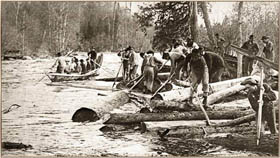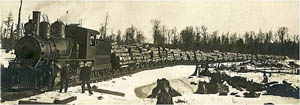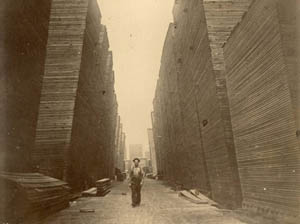Prior to the arrival of a state road in 1877 and railroad in 1881, the primary means of transportation to the cold-water zone of the Namekagon River was by river or trail. Early logging on the Namekagon was
 accomplished through logging of trees close enough to the river that they could be floated to sawmills downstream. The earliest logging on the Namekagon River was summarized by Eldon Marple, an expert on Sawyer County history. The best timber along river banks was illegally harvested from federal owned forested land because logs could be floated downstream to the sawmill without the need for proving origin; this illegal harvest was termed “bank chances”. The earliest accounts of bank chance harvest along the Namekagon River were from 1861. The early loggers that explored the cold-water zone for bank chances described the floodplain as lacking large white pine timber. Eldon Marple explained that the sandy soils of the Namekagon River flats between the river and the surrounding hills supported groves of red pine and jack pine, which were less profitable timber species that the white pine in the nearby hills.
accomplished through logging of trees close enough to the river that they could be floated to sawmills downstream. The earliest logging on the Namekagon River was summarized by Eldon Marple, an expert on Sawyer County history. The best timber along river banks was illegally harvested from federal owned forested land because logs could be floated downstream to the sawmill without the need for proving origin; this illegal harvest was termed “bank chances”. The earliest accounts of bank chance harvest along the Namekagon River were from 1861. The early loggers that explored the cold-water zone for bank chances described the floodplain as lacking large white pine timber. Eldon Marple explained that the sandy soils of the Namekagon River flats between the river and the surrounding hills supported groves of red pine and jack pine, which were less profitable timber species that the white pine in the nearby hills.
In 1881, the Chicago, St. Paul, Minneapolis, and Omaha Railway (The Northwestern Line) connected Spooner to Cable, bringing passenger and freight transportation to the Upper Namekagon River, allowing lumber companies to export their products to city markets. Large-scale logging began in 1881 on the Upper Namekagon River. By this time, many of the timber stands of the lower Namekagon and St. Croix were already exploited. 
In 1885, the Wisconsin Legislature authorized Anthony J. Hayward “to build, maintain and operate damsand other improvements across the Namakagon River and its tributaries, above… Hayward.” The law required dams to be constructed and maintained so that logs could pass through sluice gates. The  dams could only be operated up totwelve hours per day so that natural flow of the river would not be diminished in order to guarantee flow to the flowage dams downstream of Hayward.
dams could only be operated up totwelve hours per day so that natural flow of the river would not be diminished in order to guarantee flow to the flowage dams downstream of Hayward.
As the logging era came to a close when the once vast stands of white pine dwindled, The Northwestern Line promoted tourism in northern Wisconsin. Although the lines were primarily used for freight, passenger service connected to larger cities including Chicago, Louisville, Milwaukee, St. Louis, and St. Paul. Pamphlets published by The Northwestern Line as early as 1885 touted fishing and hunting opportunities in towns along railroad. By 1901, the era of floating logs on the Namekagon River came to a close as logging railroads carried out remaining timber to the sawmills. The human footprint at the end of the logging era left a river warmed by dams and sunlight once shaded by bank vegetation.
You Are Here:
Home > History by Era > Logging
